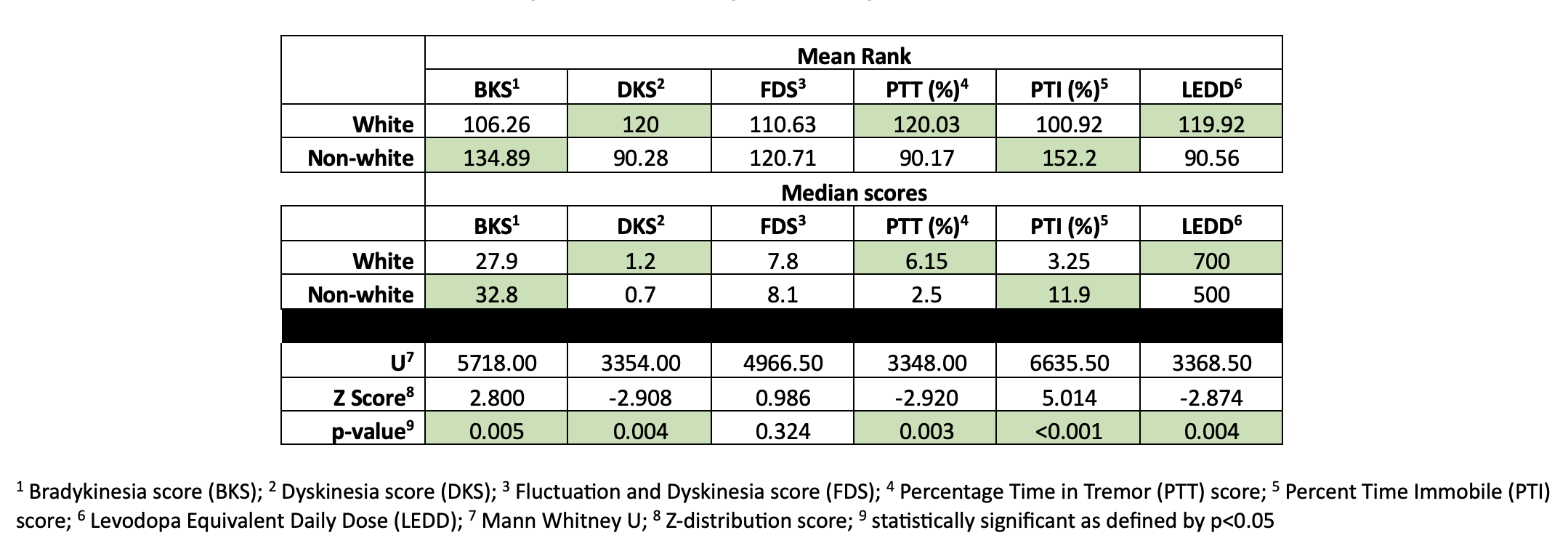Category: Parkinsonism, Others
Objective: Using the Parkinson’s KinetiGraph (PKG) reports of PwP to determine if scores vary according to ethnicity, classed as white or non-white PwP (Black, Asian, and Other ethnic minorities).
Background: Parkinson’s disease (PD) presentation in white and non-white people with Parkinson’s (PwP) has been shown, over the past decade, to vary in motor and nonmotor symptoms [1,2].
Method: Data analysis was collated from the UK-arm of the global PKG Registry and the UK-arm of the Nonmotor International Longitudinal Study. Of the potential PwP from both studies, only 225 PwP were included in the final analysis which accounted for missing data, ethnicity coding, and PKG report data. PwP were matched for age of onset, age at time of PKG report, and Hoehn and Yahr stage.
Results: This updated analysis of 225 PwP encompassed 66.7% white PwP and 33.3% non-white PwP (Table 1). A Mann-Whitney U test was run to determine if there were differences in PKG scores between white and non-white PwP. Distribution of bradykinesia (BKS), dyskinesia (DKS), time in tremor (PTT), and time immobile (PTI) were not similar between the two groups, as assessed by visual inspection. The BKS and PTI scores for non-white PwP (mean rank = 134.89 and 152.2, respectively) were statistically significantly higher than that of white PwP (mean rank = 106.26 and 100.92, respectively) (Table 2). However, the DKS score and PTT score for white PwP (mean rank = 120 and 120.03) was statistically significantly higher than that of non-white PwP (mean rank = 90.28 and 90.17). Furthermore, the Levodopa equivalent total daily dose (LEDD) for white PwP (mean rank = 119.92) was statistically significantly higher than that of non-white PwP (mean rank = 90.56) U = 3368.5, z = -2.874, p<0.004.
Conclusion: This updated analysis combining two datasets to evaluate PKG reports between different ethnic groups, shows non-white PwP are more likely to have bradykinesia and immobility as more problematic symptoms, and furthermore are more likely to be underdosed as suggested by lower LEDD score. In comparison to the white PwP who are more likely to have higher dyskinesia and tremor scores and higher LEDD scores. This updated analysis shows there to be ethnical differences in symptoms but also in treatment of white and non-white PwP.
Table 1: Patient Demographics
Table 2: Summary of Mann-Whitney U test analysis
References: [1] Sauerbier A, Aris A, Lim EW, Bhattacharya K, Ray Chaudhuri K. Impact of ethnicity on the natural history of Parkinson disease. Med J Aust. 2018 May 21;208(9):410-414. doi: 10.5694/mja17.01074. PMID: 29764354.
[2] Rukavina K, Ocloo J, Skoric MK, Sauerbier A, Thomas O, Staunton J, Awogbemila O, Trivedi D, Rizos A, Chaudhuri KR; King’s Parkinson’s Disease Pain Scale Group. Ethnic Disparities in Treatment of Chronic Pain in Individuals with Parkinson’s Disease Living in the United Kingdom. Mov Disord Clin Pract. 2022 Mar 9;9(3):369-374. doi: 10.1002/mdc3.13430. PMID: 35392300; PMCID: PMC8974878.
To cite this abstract in AMA style:
MA. Qamar, L. Batzu, D. Trivedi, K. Ray Chaudhuri. PKG-Ethnicity project: An initial analysis of ethnical differences in Parkinson’s KinetoGraph (PKG) results between white and non-white ethnic groups [abstract]. Mov Disord. 2024; 39 (suppl 1). https://www.mdsabstracts.org/abstract/pkg-ethnicity-project-an-initial-analysis-of-ethnical-differences-in-parkinsons-kinetograph-pkg-results-between-white-and-non-white-ethnic-groups/. Accessed April 18, 2025.« Back to 2024 International Congress
MDS Abstracts - https://www.mdsabstracts.org/abstract/pkg-ethnicity-project-an-initial-analysis-of-ethnical-differences-in-parkinsons-kinetograph-pkg-results-between-white-and-non-white-ethnic-groups/


